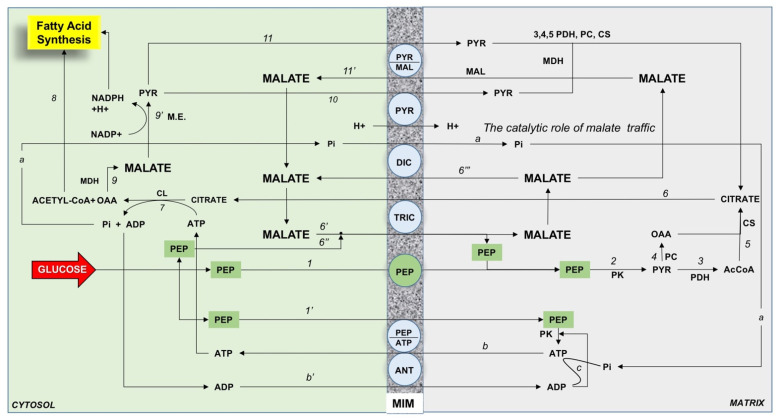Figure 3.
The role of the phosphoenolpyruvate (PEP) dependent mitochondrial traffic in rabbit kidney fatty acid synthesis. The following scenario is proposed: PEP enters mitochondria via the putative PEP carrier (1); inside the matrix PEP produces pyruvate (PYR) via the mitochondrial pyruvate kinase (PK) (2); PYR is both oxidized to acetyl-CoA via the pyruvate dehydrogenase (PDH) (3) and carboxylated to oxaloacetate (OAA) via the pyruvate carboxylase (PC) (4); acetyl-CoA and OAA gives citrate via the citrate synthase (CS) (5); citrate is exported in the cytosol (6) in exchange with malate (6′) and/or PEP (6″); in the cytosol citrate produces OAA and acetyl-CoA via the ATP-citrate lyase (CL) (7); acetyl-CoA is used for fatty acid synthesis (8); OAA is reduced to malate via the cytosolic malate dehydrogenase (9); malate gives NADPH for fatty acid synthesis and PYR via the malic enzyme (M.E.) (9′); PYR enters mitochondria via its own carrier (10) and in exchange with malate via the PYR/malate antiporter (11); malate just exported and that exported via the dicarboxylate carrier in exchange with phosphate formed in the CL reaction (a) promotes further citrate efflux in a catalytic traffic. In this manner, most of the malate formed in (9) is available for NADPH production. ATP formed in PK reaction is exported in the cytosol in exchange with PEP (b) via the putative PEP/ATP antiporter and or in exchange with ADP (b′) to provide further ATP via ATP synthase (c). Legend: MIM, mitochondrial inner membrane.

